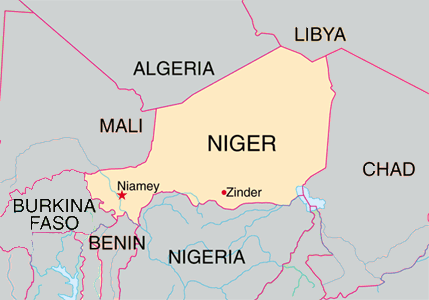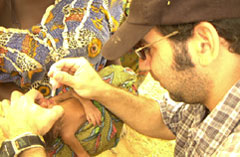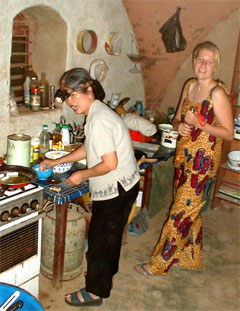|
|
|
|
Letter form Niger, April 2004
By J.R. Bullington
*
The director of the U. S. Peace Corps program in Niger continues a tradition of more than three years standing by sending to the journal yet another exclusive report. As is always the case, Amb. Bullington presents a fascinating glimpse of the volunteers' lives. –Ed.
Days of Dust and Mangos
The persistent wind that carries all-enveloping clouds of dust from the Sahara across most of West Africa (and often well out into the Atlantic Ocean) is known as the harmattan. This year, at least in Niger, it began in early February and continued, with varying intensity, through the end of March, which is longer that we've experienced in past years.
On some days, the harmattan dust is like a light summer haze, and on others it's like a heavy fog, cutting visibility down to a couple of hundred yards or less. There's no escaping it, even inside air-conditioned houses, where it leaves a daily coat of dust on everything. It irritates throats and sinuses and is held responsible (rightly or wrongly) for all sorts of illnesses from colds to meningitis. Sometimes you can even taste it. It occasionally causes airport closures and road accidents.
On the positive side, the dust clouds block much of the sunlight and thus prolong the relatively moderate temperatures of Niger's brief winter, when afternoon readings only get into the low 90s. Now, in early April, the skies are clearing; the temperatures are rising (soon to reach 110 or even 120 in mid-afternoon), and the mangos are ripening to provide a bountiful hot season treat.

Peace Corps and Presidential Politics
Peace Corps, happily, has not been a part of the current electoral campaign. It has long enjoyed widespread bipartisan support (at least in principle—funding has been, and remains, a problem); and both the President and Senator Kerry have publicly proposed dramatic expansion in the number of Volunteers.
President Bush, in his 2002 State of the Union address, said:
And America needs citizens to extend the compassion of our country to every part of the world. So we will renew the promise of the Peace Corps, double its volunteers over the next five years, and ask it to join a new effort to encourage development, and education, and opportunity in the Islamic world.
The President subsequently proposed budget increases consistent with this growth rate, which would take the number of Volunteers to 14,000 in 2007. Congress has appropriated enough for some growth, though not nearly as much as the President called for. The overall number of Volunteers grew from about 7000 in 2002 and prior years to about 7500 in 2003. This represents the highest number of Volunteers since 1975. However, the FY04 appropriation ($308 million) is barely enough to sustain current operations, and plans for further growth in 2004 have been scrapped. (In Niger, we grew from an average of 90 to about 110 Volunteers currently, but our plan for a further increase to about 130 this year and next is on indefinite hold.)
Senator Kerry in a speech last May proposed an even more ambitious expansion of Peace Corps, to 25,000 Volunteers. I don't know whether this is still a part of his plat-form, but even if it is, it's hard to be sanguine about his ability to get anything approaching the necessary funding in the current budget climate. President Clinton called for growth to 10,000 Volunteers, but in fact the number barely reached 7000 by the end of his term, up from about 5500 in the early 1990s.
Should Peace Corps grow further? In terms of advancing long-term US interests as well as positively impacting the lives of the poor people the Volunteers serve, I've found Peace Corps to be more cost-effective, to have a "bigger bang for the buck," than any of the foreign assistance programs delivered by the Agency for International Development and most other foreign aid organizations. (I held and often expressed this opinion when I was in the Foreign Service many years ago, long before I had even thought of becoming part of Peace Corps.) I don't think it's politically feasible to increase the total amount of foreign aid at a time of severe budget deficits, but I do wish both parties would back their positive sentiments about Peace Corps by shifting from AID or other foreign assistance accounts the relatively tiny amount of funding that would be needed for growth to at least the 10,000 Volunteer level.
Niger and the War on Terrorism
There have been recent press reports about terrorist groups operating in the Sahara and an increased US military focus on Africa in the war on terrorism. These reports, along with continuing terrorist threats and attacks worldwide, have raised understandable concern on the part of some Niger Volunteer families.
Since global terrorism leaped to the forefront of everyone's attention on 9/11, we've been monitoring the situation here as closely as we can to assess the threat to the Volunteers. As I've noted before, even though this is an overwhelmingly Muslim country, there are few Islamic extremists; the Nigerien people and Government warmly welcome the Volunteers and actively support their security; and there have been no terrorist incidents here nor are there any known Nigerien terrorists. I continue to believe that a Volunteer at his/her post in Niger is safer from terrorism than people in New York, Washington, and other major American and European cities.
This is not to say, or course, that Niger and the Americans living here are invunerable to terrorism. We are vulnerable, and there is nothing we can do short of pre-emptive surrender, i.e., withdrawing all the Volunteers and going home, to eliminate that risk.
One concern has been the possibility of a spillover of Islamic extremism and/or terrorism from neighboring countries. Notable in this regard are the states of northern Nigeria, along the Niger border, that have Islamic extremist governments with Sharia (religion-based) law, as well as the border area with Algeria, where there has been a civil war waged by Islamic extremists against the government for several years.

The Nigerian border area has remained quiet and secure. In late February, however, a band of Algerian terrorists known as the GSPC (an acronym derived from French, translated as the Salafist Group for Call and Combat) was temporarily active in far northern Niger. They were apparently just passing through the area after being chased out of Algeria by Algerian forces. They crossed far northern Niger into Chad, where they were engaged by Chadian Government forces and reportedly suffered 43 killed.
The area they transited is far remote from any Peace Corps site. Niger is almost twice as big as Texas, and all Volunteers are located in the southern third of the country.
The reports of increased US military activity in the Sahara region are related to the "Pan-Sahel Initiative," a US program that provides training and equipment to the militaries of Mauritania, Mali, Niger and Chad to help them control their borders, interdict smuggling, and deny use of their territories to terrorists and other international criminals. Training by small teams of US military personnel has taken place or is underway in Mauritania and Mali, and is scheduled for Niger and Chad later this year.
Other than the normal police and border control functions, this is pretty much the extent of Niger's involvement in the war on terrorism thus far.
Niger and the War on Polio

Since 1988, UNICEF, WHO, the US Centers for Disease Control and Rotary Interna-tional have been leading a worldwide campaign to eliminate polio, just as smallpox was eliminated several years ago. This campaign has been successful, bringing down the number of cases from tens of thousands every year to only 388 in 2003. Total elimination appeared in reach, as polio's geographic occurrence was reduced to pockets in six countries: India, Pakistan, Afghanistan, Egypt, Nigeria and Niger. Last year, however, there was a resurgence of polio in Africa, with new cases in eight previously polio-free countries. These cases were determined to have been "exported" from Nigeria.
The problem area is centered in those previously mentioned states of northern Nigeria where Islamist extremist governments are in power. These states have boycotted the polio immunization campaign after claims by some Muslim religious and political leaders in the region that the polio vaccine makes women infertile, and that immunization is part of a plot by Western governments to control the growth of Muslim populations.
The central government in Nigeria has been trying to overcome this resistance to immunization in the northern states, but with limited success.
The Government of Niger, for its part, has cooperated fully in polio immunization, and several Peace Corps Volunteers as well as visiting Rotarians from the US have been assisting with it. There was a concerted effort in late March to immunize all Nigerien children under five. President Tandja was personally commended by President Bush and by Rotary for his leadership role. Because of extensive commercial ties and frequent travel between Niger and northern Nigeria, however, polio cannot be eliminated here as long as it persists there.
Adi
One of our Volunteers, Carol Grimes, has documented aspects of her service with several articles in our quarterly Volunteer newsletter. Her articles give a vivid and moving picture of life in a rural Nigerien village. Following are extensive excerpts from her latest one:
My best friend in the village lives next door, just a peek away over low mud walls, between the lace-tipped branches of a Tamaka tree. Adi is perhaps 32 years old with 8 children: 6 living, 2 dead. She cannot leave her yard (my house excepted) without her husband's permission because she is the Malam's (religious leader) wife, and therefore cloistered. I wake up to her voice in the morning and fall asleep to it at night. I think that I am lucky that I love her so much, else I might go berserk from overexposure. We are like all neighbors here, we can't help but know each other's habits, moods, every character flaw, every weakness, every strength.
Adi comes over in the morning to chat, at noon to bring me tuwo (millet porridge), and I go over to her house as the sun sets and play with her children. And for a million more reasons we see each other in passing – as I stroll off to my field, as she runs over to borrow oil, as I steal in to hijack her fat baby for snuggle time. It is a pleasant routine, this slow dance of friendship we've created.
Last time I went on vacation I was gone for a month, arriving back in the village just as harvest had begun. Before returning, I had debated over what to bring back for Adi's entihiya (her gift from the road). Finally, I settled on a dengilay, a long, beautiful bright pink head-scarf with gold threaded designs woven throughout. I wanted her to know how much I appreciated her friendship.
As I bought the scarf at the Grand Marché in Niamey, I pictured Adi wearing it. She is tall for a Hausa woman, or even for a man, and she is skinny in a way that might make American women jealous. But she is not skinny by choice. "If Allah wills it," she says, "this year there will be enough food so that I can eat and eat and eat and get very fat." Ideally, she would like to have a big stomach and a big behind. Scarification, given to her when she was a girl, turns pretty features into beautiful. Triangles filled with small marks start at her mouth, little lines climbing out of them and up her sharp cheek bones, like miniature railroad tracks. Four deeper, thicker lines are slashed strikingly, two on either side of her button nose. They accentuate her big, dark eyes, and are often painted in with charcoal. Her neck is long and graceful, it flows from her corn-rowed braids into her chocolate back. Every part of her is sculpted and muscled from years of hard work but her back is the most defined, like a work of art, chiseled to perfection.
When I return to the village and give Adi the pink and gold head-scarf, she is ecstatic. Immediately, she wraps it over her head and around her shoulders. It cascades prettily down past her waist as she parades around my yard with a haughty show-off expression and we both break into laughter. She carries on about how much she loves it, then carefully puts it away. "Allah she miki albarka," she says, "May God give you blessings.". . .
The day after I give her the head-scarf, she sets off for Illela, a market village just across the border, in Nigeria, in order to express her sympathies on the third day of a relative's death. While in the city, suffering under the oppressive heat of the noonday sun, she cannot find a car to take her to the house. In desperation, she decides to get on a cobble-cobble taxi (moped) for the first time in her life, and ride to her destination. . .

As they spin along, baby bouncing on Adi's back, the head scarf catches a breeze and strays from her body into the tire, sticking in the spokes and tearing off, ripping half of it into tatters and staining it with dirt and oil. And there you have it, the beautiful pink and gold scarf, worn so proudly for just a few hours, now ruined beyond repair.
I imagine her gasping in despair and calling for the taxi driver to halt, picking up her scarf from the street, and exclaiming "Wayo, wayo, wayo." The taxi driver feels terrible – he will not let her pay the fare when they reach her destination. But this is her only consolation. For a woman from a rural village in Niger who receives only one or two new outfits a year from her husband, a scarf like this is a precious treat. . . She is a woman down on her luck. As if poverty, illiteracy, marriage at 13, too many pregnancies, too many dead children and an abusive husband weren't enough.
By the time Adi gets back to the village, late that afternoon, and shows me the damaged scarf, she is laughing at her misfortune. She tells me the story and we make jokes about it, about our collective bad luck. This is an invaluable lesson I've learned since coming here: when all else fails, make it into a joke. After we've calmed down our giggles, a more serious look takes on her face. The truth is, she explains, she isn't happy at all about the scarf, but she can't complain seeing as she and her baby arrived home from Illela in health. . .
We are back in the yard, Adi and I, stripping the leaves off the Tamaka tree for the umpteenth time, dipping and washing them in a calabash bowl of water. As Adi prepares the fire, I begin to feel bittersweet, not sure if I'll be ready to leave this place when my time is up—just six more months. It makes me wonder what it is in my personality that allows me to never fully appreciate what I have until it is almost gone from my reach. Especially living here, a place where, despite all the frustrations, homesickness and physical misery, I continue to be filled with unique and powerful experiences. My eyes frame the scene surrounding me and this is what I see: a remote African village, a minority culture, a different religion and lifestyle, and the few incredible people with whom I've connected in ways I could have never imagined. . .
April 12, 2004
Endnotes
Note *: J.R. Bullington is currently Country Director of the Peace Corps program in Niger. He was formerly a US Ambassador and career diplomat, with extensive service in Africa and Asia. Back